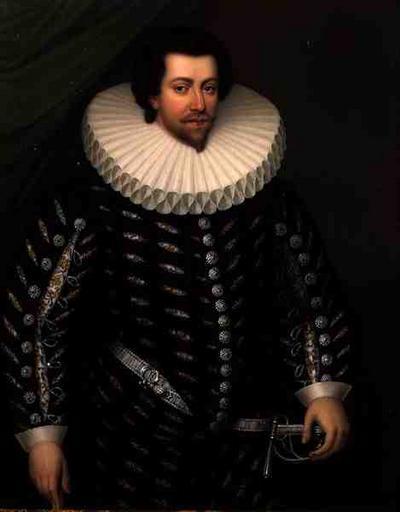MAKE A MEME
View Large Image

| View Original: | William,_Lord_Russell_of_Thornhaugh.jpg (469x600) | |||
| Download: | Original | Medium | Small | Thumb |
| Courtesy of: | www.flickr.com | More Like This | ||
| Keywords: people William Russell, 1st Baron Russell of Thornhaugh (c. 1558 – 9 August 1613) was an English military commander. Russell was a younger son of the 2nd Earl of Bedford. His birthdate is uncertain, with some records showing that he was born as early as 1553, some as late as 1562. He was educated at Magdalen College, Oxford, and in September 1581 he was knighted. Russell began his active military career in the Netherlands, and was noted for maintaining an effective fighting force in difficult circumstances. He was appointed to the office of Governor of Flushing (1587-8), and in 1594 to the office of Lord Deputy of Ireland, where he served with flamboyance. At the time, Ireland was on the point of rebellion, and there were two opinions in government on how to preserve the peace. One faction sought negotiation with the Irish rebels, while the other - including Russell - favoured military force. Russell's faction prevailed, and the rebellion grew into a general revolt, which lasted through the Nine Years War and ended with the Treaty of Mellifont in 1603. During his time in Ireland, Russell fell into dispute with his chief military commander, Sir John Norris. The dispute proved harmful to the crown government, and Russell was recalled to England in 1597, but only after he had defeated and killed the rebel Fiach MacHugh O'Byrne. In 1599, Russell was named as leader of the forces defending western England in anticipation of a Spanish invasion. However, the invasion plans were thwarted. With the help of Inigo Jones Russell developed Covent Garden and built the mansion of Woburn. In the 1590s, he consulted with three Dutchmen as to the potential for draining his manor of Thorney Abbey in Cambridgeshire; his son, Francis Russell, famously continued the family interest in drainage and led the undertakers in the first attempt to drain the Great Level of the Fens, later known as the Bedford Level. Russell was created 1st Baron Russell of Thornhaugh in 1603 but he lost influence at court and retired to his estates, where he died on August 9, 1613. Russell married on 13 February 1585 at Watford, London, Elizabeth Long, only daughter and sole heiress of Henry Long of Shingay, Cambridgeshire, and granddaughter of Sir Richard Long. William Russell, 1st Baron Russell of Thornhaugh (c. 1558 – 9 August 1613) was an English military commander. Russell was a younger son of the 2nd Earl of Bedford. His birthdate is uncertain, with some records showing that he was born as early as 1553, some as late as 1562. He was educated at Magdalen College, Oxford, and in September 1581 he was knighted. Russell began his active military career in the Netherlands, and was noted for maintaining an effective fighting force in difficult circumstances. He was appointed to the office of Governor of Flushing (1587-8), and in 1594 to the office of Lord Deputy of Ireland, where he served with flamboyance. At the time, Ireland was on the point of rebellion, and there were two opinions in government on how to preserve the peace. One faction sought negotiation with the Irish rebels, while the other - including Russell - favoured military force. Russell's faction prevailed, and the rebellion grew into a general revolt, which lasted through the Nine Years War and ended with the Treaty of Mellifont in 1603. During his time in Ireland, Russell fell into dispute with his chief military commander, Sir John Norris. The dispute proved harmful to the crown government, and Russell was recalled to England in 1597, but only after he had defeated and killed the rebel Fiach MacHugh O'Byrne. In 1599, Russell was named as leader of the forces defending western England in anticipation of a Spanish invasion. However, the invasion plans were thwarted. With the help of Inigo Jones Russell developed Covent Garden and built the mansion of Woburn. In the 1590s, he consulted with three Dutchmen as to the potential for draining his manor of Thorney Abbey in Cambridgeshire; his son, Francis Russell, famously continued the family interest in drainage and led the undertakers in the first attempt to drain the Great Level of the Fens, later known as the Bedford Level. Russell was created 1st Baron Russell of Thornhaugh in 1603 but he lost influence at court and retired to his estates, where he died on August 9, 1613. Russell married on 13 February 1585 at Watford, London, Elizabeth Long, only daughter and sole heiress of Henry Long of Shingay, Cambridgeshire, and granddaughter of Sir Richard Long. | ||||